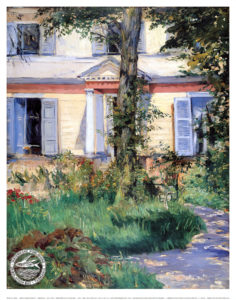MANET, Edouard
Showing the single result
Born into a prosperous Parisian household, Manet studied at Thomas Couture’s studio and at La Louvre, where he was influenced by the Spanish and Dutch masters (especially Goya and Hals). He also travelled abroad extensively.
Upon the death of his disapproving father he inherited considerable wealth, which was just as well, because at the Salon des Refuses in 1863 his work was scathingly reviewed and ridiculed. This occurred regularly and as his work was denounced and rejected, his reputation as a leader of the avant-garde grew.
In 1874 he was in Argenteuil painting out doors with Monet. His work became freer and lighter, not merely a straightforward transcription of nature, but elusive and sometimes enigmatic. By 1880 signs of locomotor ataxia (sym. late syphilis) appeared. He began to work more in pastels between the pain and tiredness, achieving painterly brilliance in ‘The bar at the Folies-Begere’ (1881) and in
‘House at Reuil’ (1882).
Official recognition came too late, a second class medal at the Salon and the Legion of Honour in 1882.
He died at the house a year later in appalling pain after having a gangerous leg amputated.
His great contribution to ‘modern art’ must include his –
‘dismissal of the traditional literary and moralistic constraints’.

